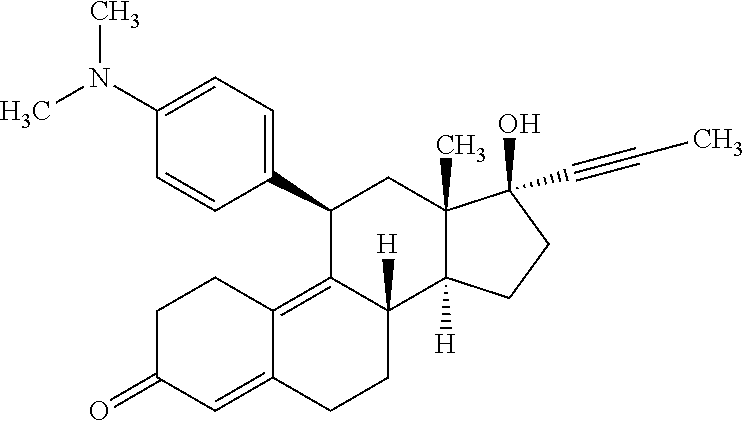Optimizing mifepristone levels for cushing's patients
a technology for optimizing mifepristone levels and patients, applied in the field of optimizing mifepristone levels for cushing patients, can solve the problems of patients not receiving an efficacious dose of mifepristone, and achieve the effect of improving the efficacy of mifepristone treatmen
- Summary
- Abstract
- Description
- Claims
- Application Information
AI Technical Summary
Benefits of technology
Problems solved by technology
Method used
Image
Examples
example 1
Determination of Mifepristone Plasma Level
[0052]This example provides a procedure for determining the plasma level of mifepristone in a patient.
[0053]Three (3) mL of blood was collected from a patient in a vacutainer containing sodium heparin. The blood was centrifuged and the resulting plasma frozen at −70 to −80° C. until assay. For analysis, the plasma samples were warmed and prepared as follows:[0054]1. Using a pipette, 50.0 μL of the sample was aliquoted into a 16×100-mm glass test tube. When a partial volume aliquot was needed, the aliquot was added to the tube and diluted to full volume with blank human plasma.[0055]2. 20.0 μL of the internal standard, mifepristone-d4 (5.00 m / mL in acetonitrile), was added to the tube, resulting in 2000.0 ng / mL mifepristone-d4 in plasma.[0056]3. The tube was vortexed for approximately 1 minute.[0057]4. 50.0 μL of 6% ammonium hydroxide was added to the tube.[0058]5. The tube was vortexed for approximately 1 minute.[0059]6. 2.00 mL of MTBE was ...
example 2
Treatment of Cushing's Syndrome
[0074]This example provides an open label study of the safety and efficacy in the treatment of Cushing's syndrome. The study was a Phase III trial performed using several investigators at several different sites. The objectives were to demonstrate the efficacy and safety of mifepristone in the treatment of Cushing's syndrome. The number of patients was 50. Patients eligible for randomization were male or nonpregnant female outpatients, and inpatients, if clinically required, with a diagnosis of Cushing's syndrome. Mifepristone was used as the test drug at 300 (1×300 mg tablet), 600 (2×300 mg tablet), 900 (3×300 mg tablet) and 1200 mg (4×300 mg tablet) once a day by mouth. Safety visits occurred at Days 21 and 35. If clinically necessary, a patient was treated as an inpatient. If early termination occurred prior to day 35, the patient returned for a safety follow up visit at day 35.
[0075]The primary efficacy endpoint was the proportion of patients with ...
example 3
Treatment of Male Patient with Cushing's Syndrome
[0080]A 50 year-old male, weighing 175 pounds, presents to physician with Cushing's syndrome. The physician prescribes 300 mg of mifepristone for seven daily doses over a period of seven days. One week later on the day of the seventh daily dose, three (3) mL of blood are collected from the patient and analyzed as described above in the specification. The dose of mifepristone is then adjusted, if necessary, to achieve mifepristone blood levels of greater than 1631 ng / mL. The mifepristone dose can be adjusted a single time to achieve mifepristone blood levels of greater than 1631 ng / mL. Alternatively, several adjustments to the mifepristone dose can be necessary to safely achieve mifepristone blood levels of greater than 1631 ng / mL.
PUM
| Property | Measurement | Unit |
|---|---|---|
| time | aaaaa | aaaaa |
| of time | aaaaa | aaaaa |
| time | aaaaa | aaaaa |
Abstract
Description
Claims
Application Information
 Login to View More
Login to View More - R&D
- Intellectual Property
- Life Sciences
- Materials
- Tech Scout
- Unparalleled Data Quality
- Higher Quality Content
- 60% Fewer Hallucinations
Browse by: Latest US Patents, China's latest patents, Technical Efficacy Thesaurus, Application Domain, Technology Topic, Popular Technical Reports.
© 2025 PatSnap. All rights reserved.Legal|Privacy policy|Modern Slavery Act Transparency Statement|Sitemap|About US| Contact US: help@patsnap.com

